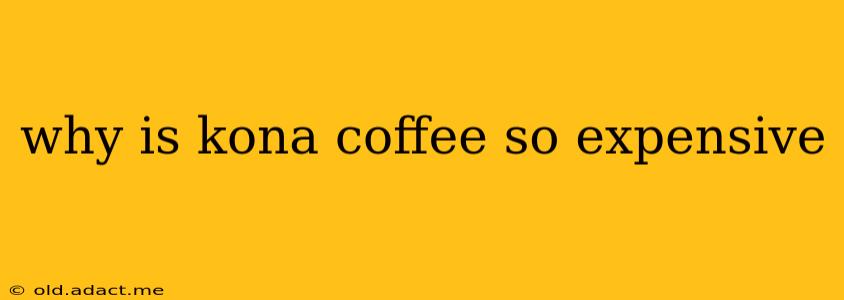Kona coffee, grown on the slopes of the volcanic Hualalai and Mauna Loa mountains on the Big Island of Hawaii, enjoys a reputation as one of the world's most exquisite and expensive coffees. But what justifies this premium price tag? It's not simply a matter of hype; several factors contribute to Kona coffee's high cost, making it a truly special and sought-after brew.
What Makes Kona Coffee Unique? The Geographical and Environmental Factors
Kona coffee's high price is intrinsically linked to its unique terroir. The volcanic soil, rich in minerals and nutrients, is ideal for cultivating Arabica beans. The region's microclimates, characterized by abundant rainfall, sunshine, and cooling trade winds, create the perfect environment for slow-growing coffee cherries that develop exceptional flavor profiles. This specific combination of factors is difficult to replicate elsewhere, contributing significantly to Kona coffee's exclusivity.
The Labor-Intensive Process: Hand-Picked Perfection
Unlike many coffee plantations that employ machinery for harvesting, Kona coffee cherries are predominantly hand-picked. This painstaking process ensures that only ripe, high-quality cherries are selected, further contributing to the final product's exceptional quality. The meticulous hand-picking is time-consuming and labor-intensive, adding to the overall cost.
Strict Regulations and Quality Control: Maintaining the Kona Standard
Hawaii has strict regulations governing the production and labeling of Kona coffee. Only coffee beans grown within the Kona district can be legally labeled as "100% Kona Coffee." This strict quality control ensures that consumers receive the authentic product they're paying for, maintaining the coffee's high reputation and justifying its price. However, it also limits production and supply, contributing to scarcity and driving up costs.
Is Kona Coffee Worth the Price? A Matter of Taste and Value
Whether or not Kona coffee is "worth it" is a subjective question. The high price reflects the exceptional quality, the unique terroir, and the labor-intensive production methods. For many coffee aficionados, the smooth, subtly sweet, and complex flavor profile justifies the cost. Others may find equally delicious coffees at more affordable prices. Ultimately, the decision rests on individual preference and budget.
How Can I Tell if My Kona Coffee is Authentic?
Many consumers worry about purchasing counterfeit Kona coffee. Here's how to increase your chances of buying genuine Kona coffee:
- Look for reputable sellers: Purchase from established coffee retailers with a strong reputation for quality and authenticity.
- Check the labeling carefully: Ensure the label clearly states "100% Kona Coffee" and specifies the coffee's origin. Beware of vague or misleading labels.
- Consider the price: While extremely low prices should raise suspicion, incredibly high prices aren’t always a guarantee of authenticity.
What are the different grades of Kona coffee?
While there isn't a formal grading system like some other coffee regions use, the quality of Kona coffee is largely determined by the careful selection and processing of the beans. The higher the quality of the bean and the more meticulous the processing, the higher the price. There aren't distinct "grades" in terms of naming conventions but the quality reflected in the cup will generally dictate the price.
Are there more affordable alternatives to Kona coffee?
Yes, absolutely! Many other coffee-growing regions produce exceptional Arabica beans with unique flavor profiles at more accessible price points. Exploring different origins can lead to discovering new favorites without breaking the bank.
In conclusion, the high price of Kona coffee reflects a combination of factors: its unique terroir, the meticulous hand-picking process, strict regulations, and limited supply. While it’s a premium product, discerning coffee drinkers find its exceptional quality and distinctive flavor profile to be worth the investment. However, there are many other delicious and high-quality coffee options available at a variety of price points.
